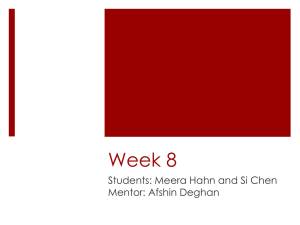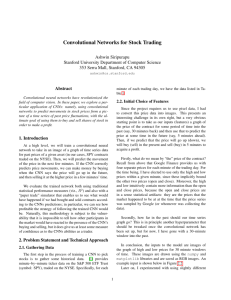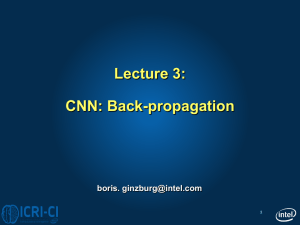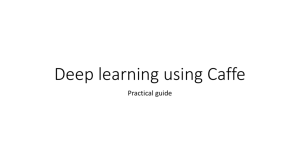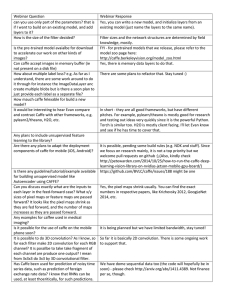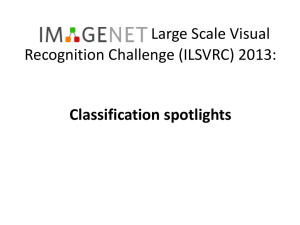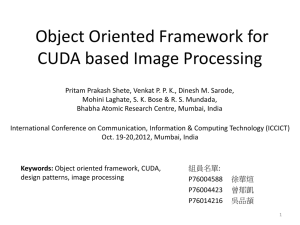Lecture 2 Caffe - getting started
advertisement
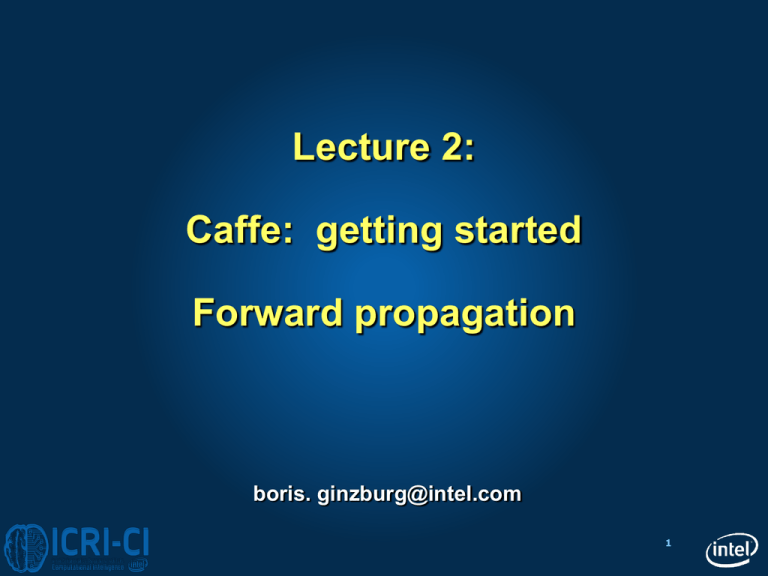
Lecture 2:
Caffe: getting started
Forward propagation
boris. ginzburg@intel.com
1
Agenda
Caffe – getting started
Test description
Network topology definition
Basic layers: definition and forward propagation
–
–
–
–
–
Convolutional
Pooling
ReLU
Fully Connected layer
Softmax
Implementation details of Convolutional layer
MNIST training
2
Open-source Deep Learning libraries
1. https://code.google.com/p/cuda-convnet2/
Just released. Excellent intro into CNN. Best Cuda.
2. http://torch.ch/ :
Excellent tutorial, C++/Cuda, Lua.
3. http://caffe.berkeleyvision.org/
Very fast. C++/ CUDA, Python and Matlab wrappers
4. http://deeplearning.net/software/pylearn2/:
Integrated with Theano, C++/Cuda, Python
5. http://torontodeeplearning.github.io/convnet/
C++/CUDA.
3
4
Caffe: installation
1. Ubuntu 12.04
2. Cuda 5.5 or 6.0 (SW - required, NVidia card is
optional)
3. BLAS: OpenBLAS or Intel MKL(Math Kernel Lib)
$ git clone https://github.com/BVLC/caffe
5
Caffe: example 1 - MNIST
Database: http://yann.lecun.com/exdb/mnist/
Demo: http://yann.lecun.com/exdb/lenet/index.html
6
Caffe: database format
src/tools/convert_mnist_data.cpp: MNIST format leveldb
1. leveldb: https://code.google.com/p/leveldb/
– Keys and values are arbitrary byte arrays
– Data is stored sorted by key; callers can provide a custom
comparison function to override the sort order.
– The basic operations : Put(key,value), Get(key), Delete(key).
caffe “dev” branch supports lmdb: http://symas.com/mdb/
– key-value , data is stored sorted by key
– uses memory-mapped files: the read performance of a pure inmemory db while still offering the persistence of standard diskbased db
– concurrent
7
Caffe: configuration files
1. Solver descriptor:
http://caffe.berkeleyvision.org/mnist_solver_prototxt.html
1. Net descriptor:
http://caffe.berkeleyvision.org/mnist_prototxt.html
Parameters are defined in src/caffe/proto/caffe.proto.
Protobuf (Google protocol buffers) format - easy-to-use
automatic generation of configuration files:
https://developers.google.com/protocol-buffers/docs/overview
8
LeNet Topology
http://yann.lecun.com/exdb/publis/pdf/lecun-01a.pdf
9
LeNet topology
Soft Max
Inner Product
Inner Product
Pooling [2x2, stride 2]
Convolutional layer [5x5]
BACKWARD
FORWARD
ReLUP
Pooling [2x2, stride 2]
Convolutional layer [5x5]
Data Layer
10
Layer:: Forward( )
class Layer {
Setup (bottom, top);
// initialize layer
Forward (bottom, top); //compute next layer
Backward( top, bottom); //compute gradient
}
Forward() propagate f to next layer:
𝑦𝑙 = 𝑓 𝑤𝑙 , 𝑦𝑙−1
11
Data Layer
mnisttrainleveldb
name: "mnist"
type: DATA
data_param {
source: "mnist-train-leveldb"
batch_size: 64
scale: 0.00390625
}
top: "data"
top: "label"
data
label
12
Convolutional Layer
Data
name: "conv1"
type: CONVOLUTION
blobs_lr: 1.
blobs_lr: 2.
convolution_param {
num_output: 20
kernelsize: 5
stride: 1
weight_filler {
type: "xavier"
}
bias_filler {
type: "constant"
}
}
bottom: "data"
top: "conv1”
conv1
conv1
conv1
conv1
13
Convolutional Layer
for (n = 0; n < N; n++)
for (m = 0; m < M; m ++)
W
for(y = 0; y<Y; y++)
for(x = 0; x<X; x++)
for (p = 0; p< K; p++)
for (q = 0; q< K; q++)
yL (n; x, y) += yL-1(m, x+p, y+q) * w (m , n; p, q);
M
N
K
X
Y
Add bias…
14
Pooling Layer
name: "pool1"
type: POOLING
pooling_param {
kernel_size: 2
stride: 2
pool: MAX
}
bottom: "conv1"
top: "pool1"
for (p = 0; p< k; p++)
for (q = 0; q< k; q++)
yL (x, y) = max( yL(x, y), yL-1(x*s + p, y*s + q) );
Poolinh helps to extract features that are increasingly invariant to
local transformations of the input image.
15
Inner product (Fully Connected) Layer
name: "ip1"
type: INNER_PRODUCT
blobs_lr: 1.
blobs_lr: 2.
inner_product_param {
num_output: 500
weight_filler {
type: "xavier"
}
bias_filler {
type: "constant"
}
}
bottom: "pool2"
top: "ip1"
YL (n) = ∑ WL(n, m) * YL-1 (m)
16
ReLU Layer
layers {
name: "relu1"
type: RELU
bottom: "ip1"
top: "ip1"
}
YL (n; x, y) = max( YL-1(n; x, y), 0 );
17
SoftMax + Loss Layer
X[0..9]
label
layers {
name: "loss"
type:
SOFTMAX_LOSS
bottom: "ip2"
bottom: "label"
}
Combines softmax:
YL [i] = exp (YL-1[i] ) / ( ∑ (YL-[i] );
with log-loss :
E = - log (YL-(label (n) )
18
LeNet topology
Soft Max
10x1
Inner Product
10x1
ReLUP
500x1
Inner Product
500x1
Pooling [2x2, stride 2]
50x4x4
Convolutional layer [5x5]
50x8x8
Pooling [2x2, stride 2]
20x12x12
Convolutional layer [5x5]
20x24x24
Data Layer
1x28x28
19
SOME IMPLEMENTATION
DETAILS
20
Data Layer
All data is stored as BLOBs – Binary (Basic) Large Objects
class Blob {
Blob( int num, int channels, int height, int width);
const Dtype* cpu_data() const;
const Dtype* gpu_data() const;
…
protected:
shared_ptr<SyncedMemory> data_; // containter for cpu_ / gpu_memory
shared_ptr<SyncedMemory> diff_; // gradient
int num_;
int channels_;
int height_;
int width_;
int count_;
}
21
Convolutional Layer : im2col
Implementation is based on reduction of convolution layer
to matrix – matrix multiply (See Chellapilla et all , “High
Performance Convolutional Neural Networks for Document Processing” )
22
Convolutional Layer: im2col
23
Convolutional Layer: groups
AlexNet topology (Imagenet)
24
Exercises
1. Play with Mnist topologies
– How accuracy depends on topology?
2. Port one of following datasets
http://deeplearning.net/datasets :
– NORB, SVHN, …
3. Look at the definition of following layers:
– sigmoid, tanh,
25
